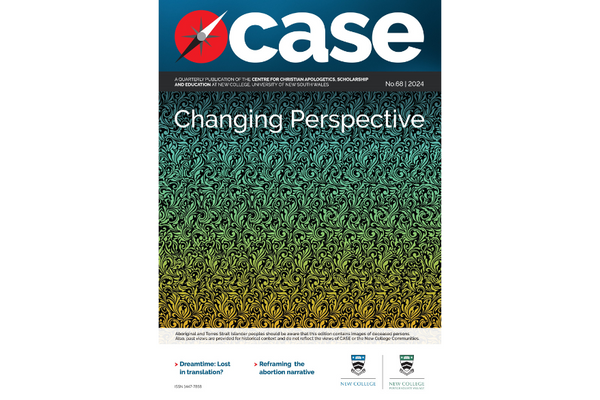Economists, Christians and the 'Marriage Wars'

In a world where a significant degree of social mobility, economic empowerment and sexual freedom is available, marriages are maintained increasingly as a result of personal choice rather than external compulsion. Reflecting these choices, the number of first marriages that ended in divorce has climbed rapidly from the mid-twentieth century, though it may have peaked in the 1970s.
In such an environment the ‘vision’ of marriage that is adopted—both social and private—is paramount. Since the early 1980s, the vision of economists has been placed alongside other visions in what we might call the ‘Marriage Wars’ —an often acrimonious debate about the fundamental nature of marriage.
This ‘economic approach’, descends from the path-breaking (and Nobel prize-winning) analysis of Gary Becker and his successors. It is based on the ‘productive’ gains that are available from specialisation in market production and household production, and in the production of children. In the writings of more recent theorists, the gains are then shared on the basis of an implicit contract between the husband and wife.
Historically, Christians have had something to say about marriage, as centuries of uttered Christian marriage vows in the West testify. But how does it compare with this relatively new voice of the economics profession?
The 'Economic' Approach
In 1981 Gary Becker published A Treatise on the Family.[2] There are a number of famous insights in this book, which ultimately won Becker the Nobel Prize. He saw the family as a kind of firm engaged in various market and nonmarket activities. He described many possible goals for married partners, the most obvious of which was the ‘production’ of children. He made a distinction between ‘quality’ and ‘quantity’ of children, and said that the former was a major goal of household production in rich economies, while the latter was the goal in poor economies.
A key concept was the idea of ‘human capital’, an example of which would be skill acquired by repeating tasks. He showed that specialisation in the household made sense because each partner could get better at operating in their spheres as a result of acquiring human capital. Thus, as well as producing children, a marriage allows efficiency gains from specialisation.
To use economic analysis, Becker had to have agents respond to price signals, but how could prices be measured in non-market activities? His innovative use of so called “shadow prices” dealt with this issue. He argued that much household production is motivated by implicit, rather than explicit, prices. Importantly, he argued that the female wage rate available outside the home was a key determinant of the allocation of time within the household. The term “shadow price” refers to the fact that the female wage casts a shadow into the woman’s time allocation decisions. By recognising this wage as a shadow price of the wife’s time, Becker was able to introduce economic price theory extensively into his analysis of the family.
Becker argued that when wage rates rise, married women who had been employed in unpaid ‘household production’ (including child bearing and rearing) switch their labour into the market sector and have fewer children. As they do so, the benefits of specialization in marriage become less pronounced. With fewer benefits on offer in marriage, divorce can potentially become more attractive.
Becker placed a great emphasis on this mechanism. Writing of the post-war US (and worldwide) phenomena of high divorce rates, more cohabitation (living together), and declining fertility[3] he asserted:
I believe the major cause of these changes is the growth in the earning power of women as the American economy developed … A growth in the earning power of women raises the labour force participation of married women by raising the forgone value of time spent at non-market activities. It also raises the relative cost of children and thereby reduces the demand for children … The gain from marriage is reduced by a rise in the earnings and labour force participation of women and by a fall in fertility because a sexual division of labour becomes less advantageous. And divorce is more attractive when the gain from marriage is reduced.[4]
Since we will later compare Becker’s vision of marriage to another vision (drawn from Judaeo-Christian ethics), it is important to be clear about Becker’s attitude to altruism. In contrast to later theorists, as we shall see, he took altruism very seriously. He argued that non market production in the home should be treated as economic activity, in which case roughly half of all economic activity would occur in the home, where altruism was the dominant motivator.
On reading this, one might think that the Becker’s analysis was a force for the maintenance of ‘traditional’ (mid-twentieth century) marriage. His analytic tools imply that a ‘stay at home and have children’ strategy for women keeps divorce rates low, yet this implication is rarely pursued by economists. This is part of a general pattern that can be observed about Becker’s profound influence. His vision of marriage as an instrumental utilitymaximising arrangement and his related use of shadow prices have had more enduring significance on the economics profession than his genuine respect for altruism. As is often the case, when a bold thinker introduces a new style of analysis, it is left to his followers to take the analysis to its logical endpoint.
To see how later thinkers carried forward Becker’s vision, consider how altruism has fared in the work of subsequent theorists.[6] Becker assumed a selfinterested view of relationships in the marriage market, where people search for partners (or their parents search, in the case of arranged marriages). Then, he assumed a degree of altruism for married people. However, when modelling divorce, Becker’s agents compared their utility in marriage with that available in the re-marriage market, eschewing altruism. This made later theorists uneasy. Economic theorists do not like inconsistency in economic actors’ motives (identified as their preferences). It seemed unacceptably untidy to have people being selfish in the marriage market, only to turn into altruists after the wedding day. Indeed, Becker had himself strongly advocated the theoretical stance of ‘stable preferences’. His vision of economic methodology consisted of “maximising behaviour, market equilibrium, stable preferences, used relentlessly and unflinchingly…”[7]
Theorists after Becker may have had other reasons to think about marriage in new ways. Perhaps influenced by increased prevalence of divorce or cohabitation, it may have seemed more and more compelling to model people acting in an instrumental way. That is, more weight was given to the notion that people’s behaviour within marriage was influenced by the outside options (either divorce, or low-commitment marriage). All this is just to say that theory is not created in isolation from the social milieu of the theorists.
A number of different directions have been explored since Becker. These are very clearly outlined in Lundberg and Pollak.[8] Becker had analysed ‘family demands’ (the demands of family members for goods and services) using a common preference approach, where the family is treated as a single decision maker. By contrast, later work emphasised the bargaining that takes place between the husband and wife (children are usually ignored), each seeking to pursue his or her own ends.
Lundberg and Pollak claim that dissatisfaction with the common preference approach stemmed from economic analysis of decisions to marry and to divorce. The comparison of ‘unmarried’ preferences implicit in these decisions sat oddly with the assumption of altruism within marriage required by the common preference approach.
These theorists went down the path of exploring so-called Nash bargaining within marriage.[9] The solution to Nash bargaining depends upon the ‘threat point’ defaulted to in the event of disagreement. To quote Lundberg and Pollak:
The utility received by husband or wife in the Nash bargaining solution depends upon the threat point; the higher one’s utility at the threat point, the higher one’s utility in the Nash bargaining solution. This dependence is the critical empirical implication of Nash bargaining models; family demands [that is, who gets what within a marriage] depend not only on prices and the total family income, but also on determinants of the threat point.[10]
The threat point need not be based on outcomes in the event of divorce. Lundberg and Pollak developed a ‘separate spheres’ model, where the threat point is internal to the marriage. The husband and wife settle their difference by Nash bargaining, but the alternative to agreement is a non-cooperative existence within marriage. To sum up developments since Becker, the use of bargaining models has contributed to a sea-change in economic analysis of marriage. While the common preference model still has influence, marriage is increasingly seen as an ongoing bargain in the literature. The key feature of a bargain is that one is always looking at the options outside, ready to act, or threaten, if it is in one’s interests to do so. This way of modelling people has the supposed virtue of giving a couple the same underlying preferences on their honeymoon, that they have when they are courting or in court.
Bargaining models place distribution within marriage[11] in a theoretical framework that is consistent with existing analyses of marriage and of divorce: two decision makers with well-defined preferences[12] choosing an action or strategy from a well-specified set of alternatives.[13]
Yet this is not the end of the story; there is a surprising twist to this stream of research. When the marital bargaining game is repeated, the model predicts many, equally likely, outcomes. At this point, Lundberg and Pollak introduce a range of factors outside the conventional scope of economic analysis, such as culture, gender conflicts and power relations to determine which outcomes are, in fact, chosen.
We couldn’t agree more that these phenomena can be important for marriages, but there is an implication for the discipline of economics which should not be passed over lightly. When economists draw on non-economic factors to explain the choice among equally likely outcomes, one suspects it is really an admission of the limits of economic analysis. For if both an economist and a non-economist can agree on the relevance of, say, power in male-female relationships, the non-economist is surely at liberty to ask why the economist believes that the discipline of economics provides the ultimate perspective. Or for that matter, could not a Christian claim that love and relationship valued for their own sake (not for their instrumental value in increasing utility) is the main business of marriage, yet allow a secondary role for economic analysis?

The ‘Covenant’ Approach
Core to the Christian understanding of marriage is the notion that humanity is the result of God’s creative activity (irrespective of how the physical science of this is understood). Thus, O’Donovan[14] describes marriage as an inbuilt goal of male/female relationship ‘…a fact of creation, and therefore not negotiable’15. This underlies the analysis of biblical materials which follows. The biblical understanding of marriage as an ideal social institution identifies five separate ‘goods’ that it promotes—relationship (Gen. 2:8), procreation (Gen. 4), social order (Gen. 2:24), sexual intimacy (1 Cor. 7:3-7) and the provision of material goods that meet the needs of the spouse (see Ash 2003, ch 7, on Gen. 1 and 2).
Marriage is identified in the Scriptures as a covenant relationship, where the covenant reflects the ‘inner’ being of the couple. So we will call the Christian approach the ‘covenant approach’.
One difference between a covenant and a commercial contract is that the former espouses unqualified commitment through all circumstances of life (‘for better, for worse’), while the latter is more easily voided by one side failing to fulfil its obligations.[16] This view of marriage-as covenant emerges from the use of marriage as an analogy for the relationship between God and his people (Exodus 20:2-6, where God is described as ‘jealous’ in language generally applied to marriage, Hosea 1-3, Ezekiel 16 and 23, and Jeremiah 3:1-5 in the Old Testament, and Christ and the church in Ephesians 5:29-32). The implication is that the marriage covenant demands complete faithfulness of the man and the woman. The depth of the covenant relationship is indicated in the phrases “naked and not ashamed” and “know”. These are more than just a description of sexual relations: Michael Hill notes that they imply deep openness of one to another within marriage, emotionally, psychologically, physically and spiritually, without feeling threatened in any way.[17]
This ideal pattern for marriage has been seriously damaged and distorted by the Fall, and the provisions of the Old Testament Law address this unsatisfactory situation.[18] One effect is on the nature of the relationship between the man and the woman, notably in their sexual relationship. In Genesis 3, “… they realised they were naked…”. In part this is a realisation of their general vulnerability, to God and to each other, but specifically of a new element in their sexual relationship. Part of the ‘curse’ is that ‘desire’ (perhaps ‘lust’) enters, and threatens to displace mutual love, with satisfaction of one’s own desires rather than satisfying the sexual needs of the other. In this context, marriage becomes a defensive social institution by regulating sexual activity, and protecting the targets of desire from predation. Hence the Christian scriptures proscribe detailed regulations on sexual relationships and marriage in Old Testament Law, for example Leviticus 18 and Deuteronomy 22. A new and confusing element is that covenant marriage starts to take on some features of a contract. The Ancient Near Eastern parallels include mutually binding agreements, stipulations and sanctions, and payments (dowry). The Pentateuch adopts many of these elements, but adds others: for example, a woman is granted the right to remain married if she has remarried after divorce (her first husband could not claim her back). These contractual provisions are consonant with the concept of marriage as a ‘public institution’ as noted by O’Donovan.[19] Society/law sets the rules, and marriage has to be contracted within that given framework. The couple cannot write a bespoke marriage contract. Marriage as a public and social institution plays an important educative role, providing a template or set of expectations within which the couple can commit to each other and develop their relationship.
A consideration of the biblical material on divorce confirms the very ‘high’ concept of marriage outlined above. The concept of divorce is very clearly present in the Old Testament. Moses permitted divorce (Deuteronomy 24:1, Exodus 21:10-11), formalised in a written certificate of divorce, and Jesus notes that this was because of their ‘hardness of heart’ (Matthew 19:8). Deuteronomy 24:1 permits divorce on grounds of an ‘indecent’ matter, which must include marital unfaithfulness. Exodus 21:10-11 permits divorce where the husband fails to provide ‘food, clothing and marital rights’.
In the New Testament, divorce is addressed in the teaching of Jesus, and in the Pauline epistles. The context of Jesus’ teaching is rabbinic Judaism. By the first century AD, there was some common ground among the rabbis concerning divorce: valid grounds were childlessness, material neglect, emotional neglect (especially refusal to have sexual relations), and unfaithfulness. Divorce was undesirable but sometimes unavoidable. It could only be enacted by a man, but courts could persuade a man to provide a certificate if the woman could show good grounds for wanting a divorce. Remarriage was accepted as the norm, but remarriage after an ‘invalid’ divorce was regarded as adultery.
But there were disagreements over the interpretation of Deuteronomy 24:1. The School of Hillel claimed that this text permitted divorce “for any matter”; the School of Shammai said that the text required “For he found in her an indecent matter”. Not surprisingly, the more liberal interpretation of the School of Hillel had become the popular norm. In Matthew 19:1-11, Jesus first affirms lifelong monogamy, and warns that it is contrary to God’s will to break up a marriage (“Therefore what God has joined together let no man put asunder”). He confirms that divorce is allowed for “a matter of indecency” because of “hardness of heart”, interpreted as a stubborn refusal to repent: but it is not compulsory, in contrast with rabbinic teaching which asserted that divorce was “commanded” in cases of adultery. But divorce “for any matter” is invalid, and hence remarriage after such a divorce is adultery. In the context of interpreting Deuteronomy 24:1 only “a matter of indecency” or “marital unfaithfulness” is a valid ground for divorce.
A key Pauline text is 1 Cor. 7:1-16, which is written to a largely non-Jewish audience. By way of background, in the Graeco-Roman world, men and women could divorce their partners simply by separating from them (sending them away, or just leaving). Marriage was expected to end in divorce rather than the death of one of the partners, and divorce was on the basis of ‘no fault’.[20] Paul states that this kind of divorce is unacceptable for Christians: in particular a believer should not separate from (divorce) an unbelieving spouse(1 Corinthians 7:12-14) simply because the spouse is an unbeliever. Paul seems to say that an abandoned spouse has the right to remarry (they are “not bound” in 7:15) but, in contrast to the culture, he commands that a leaving spouse must remain unmarried, or be reconciled (7:11).[21] The conclusion is that divorce is not to be undertaken without good cause, and the range of ‘good causes’ is very restricted. ‘No fault’ divorce is unequivocally ruled out. In a negative sense this confirms the covenant view of marriage outlined in the previous paragraphs.
The very limited acceptance of divorce does bring the covenant and economic views closer to each other behaviourally, but significant differences remain. Within the covenant view divorce is always regarded as a second-best outcome, while in the economic view it need be no more than a re-casting of an otherwise inefficient arrangement— without any sense of moral compromise. In a comment prescient of the economic approach to family, the writer C.S. Lewis noted in 1953 that Christians were in disagreement over divorce, but they shared the view that it is more like amputating a leg than dissolving a business partnership.[22]

The Marriage Wars
A comparison of the economic and covenant descriptions of what marriage is or should be identifies the following issues:
What is this thing called … marriage
There is a key difference in the characterisation of marriage. The economic analysis of marriage begins with a discussion of the gains from marriage compared to remaining single: these gains, identified first by Becker, arise from specialisation in household and market production, including learning by doing and investment in sector-specific human capital, and secondarily from economies of scale in household production and consumption. The marriage contract is concerned with the division of these gains between the partners.
By contrast, the starting point for the covenant understanding of marriage is not the gains from marriage, but the relationship between man and wife, the ‘inner commitment’ of the couple to each other in self-giving love (Greek: agape), involving openness to each other emotionally, psychologically, sexually and spiritually. This is a relationship for life: as the Anglican marriage service puts it “for better for worse, for richer for poorer, in sickness and in health, until death do us part”. An exclusive sexual relation is central to this relationship, primarily as an outward expression of the inner commitment of the couple. In this understanding, any productive ‘gains’ from marriage, and even procreation, are marital ‘goods’, by products of the relationship, and are shared by the couple on the basis of their love one for the other. Bargaining over the gains is completely alien to this model. Moreover, the marriage would still be valid if there were no productive gains (or even losses), or if one of the partners experiences a net loss of real income through the marriage. The marriage is defined solely in terms of the relationship between the partners, and not at all in terms of the ‘gains’ and how they are shared.
How close are the two views in a fallen world?
One way of looking at the contrast between the economic and covenant understandings of marriage, is to identify the covenant relationship as an ideal which is compromised by the flawed nature or ‘fallenness’ of human beings. Fallenness taken to its logical extreme results in marriages that are based on an implicit contract between partners whose relationship is characterised by self-seeking behaviour rather than love, and whose motivation in marriage is to increase their shares of the ‘gains’ of marital goods and services that a particular marriage can provide. The ‘gains’ will include sexual satisfaction, greater production of goods and services, greater access to market goods, and even the satisfaction of being parents. In practice, this view of marriage is probably too cynical. Human beings are curiously complex and their motivations are often quite mixed. The partners may genuinely love each other, and may be prepared to sacrifice themselves to each other as the covenant model requires. However, the default position may be the economic model, and many marriages may revert to that once the initial glow of romantic love has worn off. If this evaluation of the state of marriage in the advanced North American and European societies is accurate, it explains why the economics of the family can point to empirical successes in explaining marriage and divorce behaviour. In other words, the ‘reality’ of marriage in the West is often close to the economic models developed by Becker and his successors.
How are Attitudes Formed in the Marriage Wars?
If the description of the ambiguous attitudes to marriage in the previous section is correct, it prompts the question of how attitudes in a particular society are formed. In a society that gives weight to a Judaeo-Christian understanding of marriage, one might expect social mores and institutions to reflect the covenant ideal while making due allowance for human fallenness. A society that has abandoned such values will naturally drift towards an economic view of marriage, though many marriages may still be characterised, for all or part of their duration, by the covenant understanding of marriage, even though the partners would not identify with the Christian faith. The mechanisms by which social attitudes are formed are normally regarded as beyond the scope of economic analysis (indeed Becker makes it an article of faith that preferences are ‘stable’). However the educative effect of institutional norms and expectations is certainly important: in this case, the identification of marriage as a public institution with clearly defined legal expectations and procedures for making and unmaking marriages may be very significant.[23] Couples wishing to be recognised as married have to conform to the norms of marriage as specified by the law and the procedures, and cannot negotiate bespoke ‘marriage contracts’. The issue about such institutions is whether they simply reflect the norms and expectations of society at large, or whether they have some independent effect in securing old norms or establishing new ones.
This discussion raises the question as to whether the development of the economic analysis of marriage has itself had an effect on the understanding of marriage in the Western economies. The covenant model of marriage is peculiarly susceptible to the ‘corrosive’ effect of economic analysis, because marriage itself can very easily be characterised as an institutional barrier to more efficient arrangements and therefore ripe for deregulation. For example, the covenant norms of ‘permanence’ and ‘monogamy’ clearly stand in the way of divorce, remarriage and polygamy, all of which Becker shows to be economically desirable in a variety of situations. Similarly, one partner abandoning the covenant commitment and deciding to pursue self-interest within the marriage can quickly erode the trust on which the marriage has been constructed. The other partner will feel pressure to revert to a non cooperative stance if he or she is not to lose out from the selfish behaviour of his or her spouse.
The Future of Marriage?
Despite a higher divorce rate, marriage remains a popular institution in the West. Indeed, one must not suppose that an increased uptake of the economic approach to marriage will necessarily reduce its popularity. If it remains in people’s interests to marry, a self-absorbed culture will value marriage.
But it is important to remember that the mere existence of an institution can mask its wholesale transformation, as is the case for the monarchy over the last three centuries. Arguably, if marriage becomes just another business partnership, this will be a transformation that social scientists will not want to have missed— while they pored over divorce rates, fertility statistics, national accounts and A Treatise of the Family. ©
E N D N O T E S
[1] A version of this paper, Menzies G. and D. Hay (2007 or 2008) ’Economics and the Marriage Wars’ is forthcoming in the journal for the US association of Christian economists, Faith and Economics.
[2] G.S. Becker, A Treatise on the Family, Harvard University Press, Harvard, 1981.
[3] Fertility here refers to the actual bearing of children, rather than the ability to do so. The latter is called fecundity by demographers.
[4] G.S. Becker 1981, pp. 351-353.
[5] G.S. Becker 1981, p. 303.
[6] Another post-Becker development, which is not central to the argument of this paper, is the stronger emphasis on consumption complementarities in marriage (see Stevenson and Wolfers 2007, ‘Marriage and Divorce: Changes and their Driving Forces’, The Journal of Economic Perspectives (forthcoming), (Winter)).
[7] G.S. Becker, The Economic Approach to Human Behaviour, University of Chicago Press, Chicago, 1976.
[8] S. Lundberg and R.A. Pollak, ‘Bargaining and distribution in marriage’, The Journal of Economic Perspectives, vol. 10, no. 4, (Autumn), 1996, pp. 139-158.
[9] Named after the economist who is depicted in the movie ‘A Beautiful Mind’.
[10] S. Lundberg and R.A. Pollak 1996, p. 146.
[11] That is, who gets what in the marriage.
[12] That is, not suddenly switching to being an altruist on the wedding day.
[13] S. Lundberg and R.A. Pollak, 1996, p. 156, (our endnotes and italics).
[14] O.M.T. O’Donovan, Resurrection and Moral Order: an outline of evangelical ethics, second edition, IVP, Leicester, 1994, p. 69.
[15] C. Ash, Marriage: sex in the service of God, IVP Leicester, 2003, notes that this understanding is based on five key assertions. First, the creation order is moral and not just material. Second, it is indeed created, not constructed by us, whether as individuals or societies. So the ethics of marriage are an exposition of an order placed in creation by God, and not an imposition of human or social will. Marriage is a status, not a project in developing a relationship which may or may not succeed, nor a humanly constructed contract subject to renegotiation. Third, the creation order is universal, not limited to particular localities, cultures or time periods. Fourth, the creation order is revealed in Scripture, and a study of Scripture in its entirety enables us to understand that order. Finally, it is significant, an objective reality. Conforming to it brings blessing, and living otherwise invites curse.
[16] Instone-Brewer (Divorce and Remarriage in the Bible: the Social and Literary Context, Eerdmans, Grand Rapids, 2002), notes that the term for covenant in the Old Testament is also widely used for other kinds of contracts in the Ancient Near East, and he therefore cautions against regarding a ‘covenant’ as more than a contract: however the concept of covenant does develop in the theology of the Old Testament, in particular, the use of the marriage analogy for the relationship of God to his people, making it more than just a contract for services.
[17] Michael Hill, The How and Why of Love (an Introduction to Evangelical Ethics), Matthias Media, Sydney, 2002.
[18] In Christian theology, the key empirical prediction of ‘the Fall’ is that people are in a state of alienation from God, implying an anthropocentric (rather than
theocentric), ethical orientation.
[19] O.M.T. O’Donovan, ‘Marriage and Permanence’, Grove Booklets on Ethics 26, Grove Books, Bramcote, Notts, 1978.
[20] Instone-Brewer, 2003.
[21] The application of this biblical teaching on divorce remains contentious. The debate is between those who argue for an ‘indissolubilist’ position (e.g. G.J. Wenham and W.E. Heth, Jesus and Divorce, 2nd edn, Paternoster Press, Exeter, 2002), Carlisle and those who infer that divorce is permissible in quite strictly defined circumstances (O’Donovan 1978). Furthermore, a distinction is sometimes made between the rules on divorce for members of the Christian community, and those applicable to society in general. For example, the Roman Catholic church generally holds to an ‘indissolubilist’ position for marriages between Catholics, which is consistent with Paul’s position in 1 Cor 7:11.
[22] C.S. Lewis, Mere Christianity, Harper Collins, New York, 1953.
[23] This implies that changes in a legal regime, such as the introduction of no-fault divorce may have an independent impact on marriage as an institution, working through changing the understanding of marriage.
Leave a comment
Comments will be approved before showing up.



